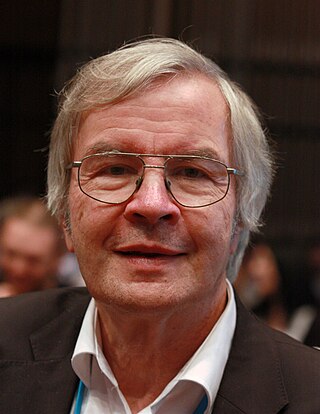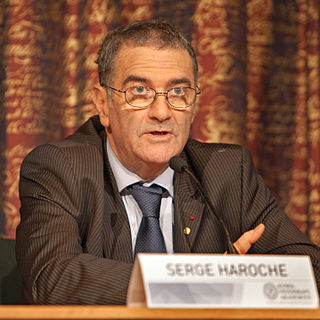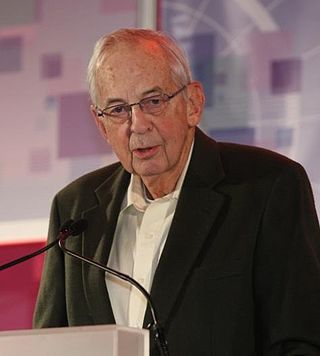Related Research Articles
Optica is a professional society of individuals and companies with an interest in optics and photonics. It publishes journals, organizes conferences and exhibitions, and carries out charitable activities.
Quantum optics is a branch of atomic, molecular, and optical physics dealing with how individual quanta of light, known as photons, interact with atoms and molecules. It includes the study of the particle-like properties of photons. Photons have been used to test many of the counter-intuitive predictions of quantum mechanics, such as entanglement and teleportation, and are a useful resource for quantum information processing.

Gérard Albert Mourou is a French scientist and pioneer in the field of electrical engineering and lasers. He was awarded a Nobel Prize in Physics in 2018, along with Donna Strickland, for the invention of chirped pulse amplification, a technique later used to create ultrashort-pulse, very high-intensity (petawatt) laser pulses.

Theodor Wolfgang Hänsch is a German physicist. He received one-third of the 2005 Nobel Prize in Physics for "contributions to the development of laser-based precision spectroscopy, including the optical frequency comb technique", sharing the prize with John L. Hall and Roy J. Glauber.
Leonard Mandel was an American physicist who contributed to the development of theoretical and experimental modern optics and is widely considered one of the founding fathers of the field of quantum optics. With Emil Wolf he published the highly regarded book Optical Coherence and Quantum Optics.
Federico Capasso is an applied physicist and is one of the inventors of the quantum cascade laser during his work at Bell Laboratories. He is currently on the faculty of Harvard University.
Philip St. John Russell, FRS, is Emeritus Director of the Max Planck Institute for the Science of Light in Erlangen, Germany. His area of research covers "photonics and new materials", in particular the examination of new optical materials, especially of photonic crystal fibres, and more generally the field of nano- and micro-structured photonic materials.

The Berthold Leibinger Innovationspreis is an award for given to those who have created applied laser technology and innovations on the application or generation of laser light. It is open to participants worldwide. It is biennially awarded by the German non-profit foundation Berthold Leibinger Stiftung. Three prizes are awarded worth 100,000 euros. The prize winners are selected from eight finalists that present their work person in a jury session. The jury is composed of international experts from different fields.
The Berthold Leibinger Zukunftspreis is an international award for "excellent research on the application or generation of laser light". Since 2006, it is biennially awarded by the German non-profit foundation Berthold Leibinger Stiftung as part of its Laser Prizes, with an amount of 50,000 euros.
The German foundation Berthold Leibinger Stiftung was founded in 1992 by the engineer, entrepreneur and patron Berthold Leibinger in Ditzingen near Stuttgart, Germany. The non-profit foundation is dedicated to cultural, scientific, church related and social issues. The capital stock amounts to 16.6 Million Euros. Since 2000 the foundation biennially awards the international innovation prize Berthold Leibinger Innovationspreis for applied laser technology. The Berthold Leibinger Zukunftspreis honors milestones in research on the application or generation of laser light since 2006. The Leibinger foundation supports the American Academy in Berlin Fellow's program.

Serge Haroche is a French physicist who was awarded the 2012 Nobel Prize for Physics jointly with David J. Wineland for "ground-breaking experimental methods that enable measuring and manipulation of individual quantum systems", a study of the particle of light, the photon. This and his other works developed laser spectroscopy. Since 2001, Haroche is a professor at the Collège de France and holds the chair of quantum physics.
Herbert Walther was a leader in the fields of quantum optics and laser physics. He was a founding director of the Max Planck Institute of Quantum Optics (MPQ) in Garching, Germany. He also was Chair of Physics at Ludwig Maximilian University of Munich. He is primarily known for his experimental work on cavity quantum electrodynamics as well his groundbreaking work on the ion trap.
The Julius Edgar Lilienfeld Prize of the American Physical Society, to remember Julius Edgar Lilienfeld, has been awarded annually, since 1989.. The purpose of the Prize is to recognize outstanding contributions to physics.

David Jeffery Wineland(born February 24, 1944) is an American Nobel-laureate physicist at the National Institute of Standards and Technology (NIST). His work has included advances in optics, specifically laser-cooling trapped ions and using ions for quantum-computing operations. He was awarded the 2012 Nobel Prize in Physics, jointly with Serge Haroche, for "ground-breaking experimental methods that enable measuring and manipulation of individual quantum systems".

James Power Gordon was an American physicist known for his work in the fields of optics and quantum electronics. His contributions include the design, analysis and construction of the first maser in 1954 as a doctoral student at Columbia University under the supervision of C. H. Townes, development of the quantal equivalent of Shannon's information capacity formula in 1962, development of the theory for the diffusion of atoms in an optical trap in 1980, and the discovery of what is now known as the Gordon-Haus effect in soliton transmission, together with H. A. Haus in 1986. Gordon was a member of the National Academy of Engineering and the National Academy of Sciences.

Anne Geneviève L'Huillier is a French physicist, and professor of atomic physics at Lund University in Sweden.

Nicolas Gisin is a Swiss physicist and professor at the University of Geneva, working on the foundations of quantum mechanics, quantum information, and communication. His work includes both experimental and theoretical physics. He has contributed work in the fields of experimental quantum cryptography and long-distance quantum communication over standard telecom optical fibers. He also co-founded ID Quantique, a company that provides quantum-based technologies.

Jun Ye is a Chinese-American physicist at JILA, National Institute of Standards and Technology, and the University of Colorado Boulder, working primarily in the field of atomic, molecular, and optical physics.
Cindy A. Regal is an American experimental physicist most noted for her work in quantum optics; atomic, molecular, and optical physics (AMO); and cavity optomechanics. Regal is an associate professor in the Department of Physics at the University of Colorado and JILA Fellow; and a Fellow of the American Physical Society (APS).

Jürgen W. Czarske is a German electrical engineer and a measurement system technician. He is the director of the TU Dresden Biomedical Computational Laser Systems competence center and a co-opted professor of physics.
References
- 1 2 3 4 "2004 Julius Edgar Lilienfeld Prize Recipient > H. Jeff Kimble". American Physical society. Retrieved June 21, 2010.
- ↑ Braunstein, Samuel L.; Kimble, H. J. (1998). "A Posteriori Teleportation". Nature. 394 (6696): 840–841. arXiv: quant-ph/9810001 . Bibcode:1998Natur.394..840B. doi:10.1038/29674. S2CID 8920410.
- ↑ Bell, Brian. "H. Jeff Kimble to Receive Quantum Physics Award". Caltech News. Retrieved January 2, 2014.
- ↑ McKeever, J.; Boca, A.; Boozer, H. J.; Buck, J. R.; Kimble, H. J. (2003). "A One-Atom Laser in a Regime of Strong Coupling". Nature. 425 (6955): 268–271. arXiv: quant-ph/0309199 . Bibcode:2003Natur.425..268M. doi:10.1038/nature01974. PMID 13679909. S2CID 839175.
- 1 2 Day, Brielle (2013). "OSA, DPG Name H. Jeff Kimble Winner of Herbert Walther Award". Physics Today. doi:10.1063/PT.4.0496.
- 1 2 3 "2004 Julius Edgar Lilienfeld Prize Recipient". American Physical Society. Retrieved January 2, 2014.
- ↑ "Fellows". American Association for the Advancement of Science. Archived from the original on January 15, 2014. Retrieved June 16, 2011. Search by Name=K and Search By Section=Physics
- ↑ "Franklin Laureate Database – Albert A. Michelson Medal Laureates". Franklin Institute. Archived from the original on April 6, 2012. Retrieved June 16, 2011.
- ↑ "Max Born Award". Optical Society of America . Retrieved June 16, 2011.
- ↑ "Berthold Leibinger Zukunftspreis". Berthold Leibinger Stiftung . Retrieved June 16, 2011.
- ↑ "Awards & Honors". The Division of Physics, Mathematics and Astronomy. June 20, 2017. Retrieved July 23, 2023.